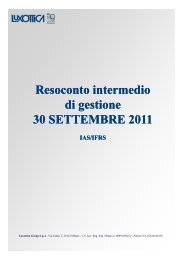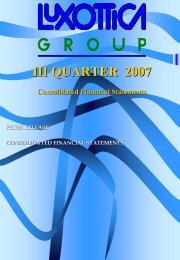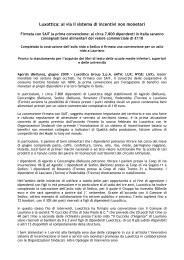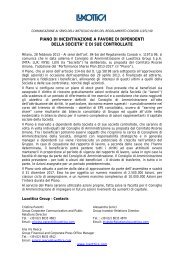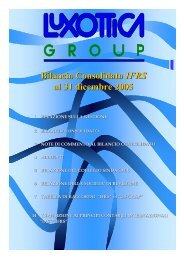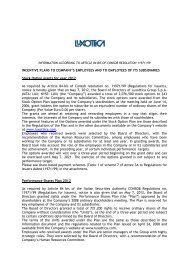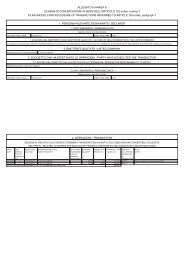703 KB - Luxottica
703 KB - Luxottica
703 KB - Luxottica
Create successful ePaper yourself
Turn your PDF publications into a flip-book with our unique Google optimized e-Paper software.
Non-US GAAP Measures:<br />
EBITDA and EBITDA margin<br />
EBITDA represents operating income before depreciation and amortization. EBITDA margin means EBITDA divided by net sales. The Company<br />
believes that EBITDA is useful to both management and investors in evaluating the Company’s operating performance compared to that of other<br />
companies in its industry. Our calculation of EBITDA allows us to compare our operating results with those of other companies without giving<br />
effect to financing, income taxes and the accounting effects of capital spending, which items may vary for different companies for reasons<br />
unrelated to the overall operating performance of a company’s business.<br />
EBITDA and EBITDA margin are not measures of performance under accounting principles generally accepted in the United States (US GAAP).<br />
We include them in this presentation in order to:<br />
improve transparency for investors;<br />
assist investors in their assessment of the Company’s operating performance and its ability to refinance its debt as it matures and incur<br />
additional indebtedness to invest in new business opportunities;<br />
assist investors in their assessment of the Company’s cost of debt;<br />
ensure that these measures are fully understood in light of how the Company evaluates its operating results and leverage;<br />
properly define the metrics used and confirm their calculation; and<br />
share these measures with all investors at the same time.<br />
EBITDA and EBITDA margin are not meant to be considered in isolation or as a substitute for items appearing on our financial statements<br />
prepared in accordance with US GAAP. Rather, these non-GAAP measures should be used as a supplement to US GAAP results to assist the<br />
reader in better understanding the operational performance of the Company. The Company cautions that these measures are not defined terms<br />
under US GAAP and their definitions should be carefully reviewed and understood by investors. Investors should be aware that <strong>Luxottica</strong> Group’s<br />
method of calculating EBITDA may differ from methods used by other companies. The Company recognizes that the usefulness of EBITDA has<br />
certain limitations, including:<br />
EBITDA does not include interest expense. Because we have borrowed money in order to finance our operations, interest expense is a<br />
necessary element of our costs and ability to generate profits and cash flows. Therefore, any measure that excludes interest expense<br />
may have material limitations;<br />
EBITDA does not include depreciation and amortization expense. Because we use capital assets, depreciation and amortization expense<br />
is a necessary element of our costs and ability to generate profits. Therefore, any measure that excludes depreciation and expense may<br />
have material limitations;<br />
EBITDA does not include provision for income taxes. Because the payment of income taxes is a necessary element of our costs, any<br />
measure that excludes tax expense may have material limitations;<br />
EBITDA does not reflect cash expenditures or future requirements for capital expenditures or contractual commitments;<br />
EBITDA does not reflect changes in, or cash requirements for, working capital needs;<br />
EBITDA does not allow us to analyze the effect of certain recurring and non-recurring items that materially affect our net income or loss.<br />
We compensate for the foregoing limitations by using EBITDA as a comparative tool, together with US GAAP measurements, to assist in the<br />
evaluation of our operating performance and leverage.<br />
See the tables on the following pages for a reconciliation of EBITDA to operating income, which is the most directly comparable US GAAP<br />
financial measure, as well as the calculation of EBITDA margin on net sales.<br />
Winning through the cycle<br />
53



